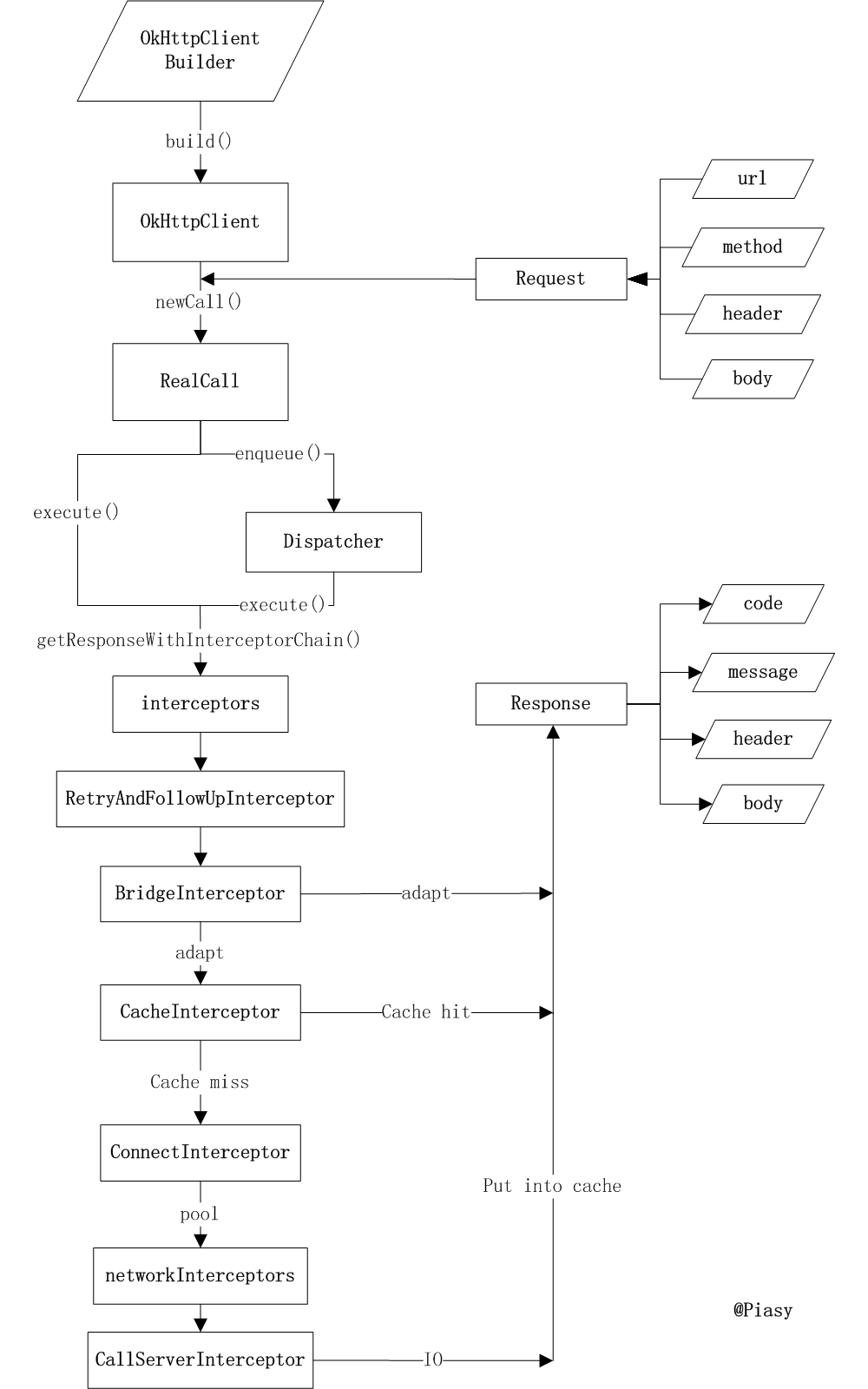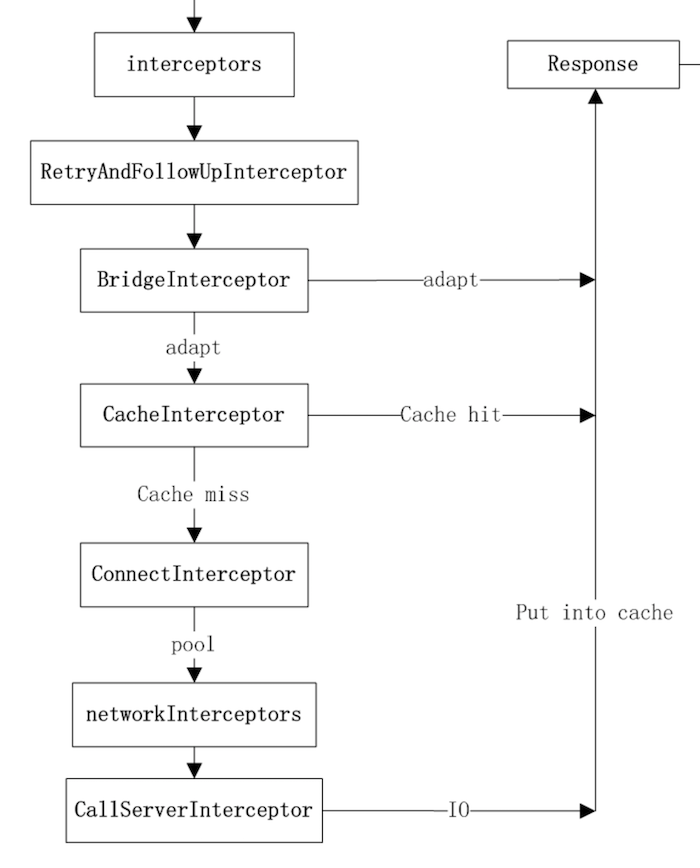参考自:okhttp解析
OkHttp源码分析
1 2 3 4 5 6 7 8 9 10 11 12 13 14 15 16 17 18 19 20 21 22 23 OkHttpClient client = new OkHttpClient ();String run (String url) throws IOException { Request request = new Request .Builder() .url(url) .build(); try (Response response = client.newCall(request).execute()) { return response.body().string(); } } client.newCall(request).enqueue(new Callback () { @Override public void onFailure (Call call, IOException e) { } @Override public void onResponse (Call call, Response response) throws IOException { System.out.println(response.body().string()); } });
创建OkHttpClient对象 1 OkHttpClient client = new OkHttpClient ();
进入构造方法
1 2 3 4 5 6 7 8 9 10 11 12 13 14 15 16 17 18 19 20 21 22 23 public OkHttpClient () { this (new Builder ()); } public Builder () { dispatcher = new Dispatcher (); protocols = DEFAULT_PROTOCOLS; connectionSpecs = DEFAULT_CONNECTION_SPECS; proxySelector = ProxySelector.getDefault(); cookieJar = CookieJar.NO_COOKIES; socketFactory = SocketFactory.getDefault(); hostnameVerifier = OkHostnameVerifier.INSTANCE; certificatePinner = CertificatePinner.DEFAULT; proxyAuthenticator = Authenticator.NONE; authenticator = Authenticator.NONE; connectionPool = new ConnectionPool (); dns = Dns.SYSTEM; followSslRedirects = true ; followRedirects = true ; retryOnConnectionFailure = true ; connectTimeout = 10_000 ; readTimeout = 10_000 ; writeTimeout = 10_000 ; }
这里采用了建造者模式,动态添加对象属性,提高代码可读性。
发起Http请求 1 2 3 4 5 6 7 String run (String url) throws IOException { Request request = new Request .Builder() .url(url) .build(); Response response = client.newCall(request).execute(); return response.body().string(); }
OkHttpClient实现了Call.Factory,负责根据请求创建新的Call。进入newCall
1 2 3 4 5 6 @Override public Call newCall (Request request) { return new RealCall (this , request); }
进入RealCall
同步网络请求 RealCallexecute()
1 2 3 4 5 6 7 8 9 10 11 12 13 14 @Override public Response execute () throws IOException { synchronized (this ) { if (executed) throw new IllegalStateException ("Already Executed" ); executed = true ; } try { client.dispatcher().executed(this ); Response result = getResponseWithInterceptorChain(); if (result == null ) throw new IOException ("Canceled" ); return result; } finally { client.dispatcher().finished(this ); } }
检查这个 call 是否已经被执行了,每个 call 只能被执行一次,如果想要一个完全一样的 call,可以利用call#clone方法进行克隆。
利用client.dispatcher().executed(this)来进行实际执行dispatcher是刚才看到的OkHttpClient.Builder的成员之一,文档说自己是异步 HTTP 请求的执行策略,现在看来,同步请求它也有掺和。
调用getResponseWithInterceptorChain()函数获取 HTTP 返回结果,从函数名可以看出,这一步还会进行一系列“拦截”操作。
最后还要通知dispatcher自己已经执行完毕。
dispatcher 这里我们不过度关注,在同步执行的流程中,涉及到 dispatcher 的内容只不过是告知它我们的执行状态,比如开始执行了(调用executed),比如执行完毕了(调用finished),在异步执行流程中它会有更多的参与。
真正发出网络请求,解析返回结果的,还是getResponseWithInterceptorChain:
1 2 3 4 5 6 7 8 9 10 11 12 13 14 15 16 17 private Response getResponseWithInterceptorChain () throws IOException { List<Interceptor> interceptors = new ArrayList <>(); interceptors.addAll(client.interceptors()); interceptors.add(retryAndFollowUpInterceptor); interceptors.add(new BridgeInterceptor (client.cookieJar())); interceptors.add(new CacheInterceptor (client.internalCache())); interceptors.add(new ConnectInterceptor (client)); if (!retryAndFollowUpInterceptor.isForWebSocket()) { interceptors.addAll(client.networkInterceptors()); } interceptors.add(new CallServerInterceptor ( retryAndFollowUpInterceptor.isForWebSocket())); Interceptor.Chain chain = new RealInterceptorChain ( interceptors, null , null , null , 0 , originalRequest); return chain.proceed(originalRequest); }
the whole thing is just a stack of built-in interceptors.
Interceptor是 OkHttp 最核心的一个东西,不要误以为它只负责拦截请求进行一些额外的处理(例如 cookie),实际上它把实际的网络请求、缓存、透明压缩等功能都统一了起来 ,每一个功能都只是一个Interceptor,它们再连接成一个Interceptor.Chain,如链条一般,环环相扣,最终圆满完成一次网络请求。关于责任链模式在下一篇博文有详细阐述。
从getResponseWithInterceptorChain函数我们可以看到Interceptor.Chain的分布依次是:
配置OkHttpClient时设置的interceptors;
负责失败重试以及重定向的RetryAndFollowUpInterceptor;
负责把用户构造的请求转换为发送到服务器的请求、把服务器返回的响应转换为用户友好的响应的BridgeInterceptor;
负责读取缓存直接返回、更新缓存的CacheInterceptor;
负责和服务器建立连接的ConnectInterceptor;
配置OkHttpClient时设置的networkInterceptors, interceptors that observe a single network request and response.
负责向服务器发送请求数据、从服务器读取响应数据CallServerInterceptor
位置决定了功能,最后一个 Interceptor 一定是负责和服务器实际通讯的,重定向、缓存等一定是在实际通讯之前的。
对于把Request变成Response这件事来说,每个Interceptor都可能完成这件事,所以我们循着链条让每个Interceptor自行决定能否完成任务以及怎么完成任务(自力更生或者交给下一个Interceptor)。这样一来,完成网络请求这件事就彻底从RealCall类中剥离了出来,简化了各自的责任和逻辑。
进入ConnectInterceptor和CallServerInterceptor,看看 OkHttp 是怎么进行和服务器的实际通信的。
建立连接:ConnectInterceptor 1 2 3 4 5 6 7 8 9 10 @Override public Response intercept (Chain chain) throws IOException { RealInterceptorChain realChain = (RealInterceptorChain) chain; Request request = realChain.request(); StreamAllocation streamAllocation = realChain.streamAllocation(); boolean doExtensiveHealthChecks = !request.method().equals("GET" ); HttpCodec httpCodec = streamAllocation.newStream(client, doExtensiveHealthChecks); RealConnection connection = streamAllocation.connection(); return realChain.proceed(request, streamAllocation, httpCodec, connection); }
建立连接就是创建了一个HttpCodec对象,它将在后面的步骤中被使用,那它又是何方神圣呢?它是对 HTTP 协议操作的抽象,有两个实现:Http1Codec和Http2Codec,顾名思义,它们分别对应 HTTP/1.1 和 HTTP/2 版本的实现。
在Http1Codec中,它利用Okio对Socket的读写操作进行封装,Okio 以后有机会再进行分析,现在让我们对它们保持一个简单地认识:它对java.io和java.nio进行了封装,让我们更便捷高效的进行 IO 操作。
而创建HttpCodec对象的过程涉及到StreamAllocation、RealConnection,代码较长,这里就不展开,这个过程概括来说,就是找到一个可用的RealConnection,再利用RealConnection的输入输出(BufferedSource和BufferedSink)创建HttpCodec对象,供后续步骤使用。
发送和接收数据:CallServerInterceptor 1 2 3 4 5 6 7 8 9 10 11 12 13 14 15 16 17 18 19 20 21 22 23 24 25 26 27 28 29 30 31 @Override public Response intercept (Chain chain) throws IOException { HttpCodec httpCodec = ((RealInterceptorChain) chain).httpStream(); StreamAllocation streamAllocation = ((RealInterceptorChain) chain).streamAllocation(); Request request = chain.request(); long sentRequestMillis = System.currentTimeMillis(); httpCodec.writeRequestHeaders(request); if (HttpMethod.permitsRequestBody(request.method()) && request.body() != null ) { Sink requestBodyOut = httpCodec.createRequestBody(request, request.body().contentLength()); BufferedSink bufferedRequestBody = Okio.buffer(requestBodyOut); request.body().writeTo(bufferedRequestBody); bufferedRequestBody.close(); } httpCodec.finishRequest(); Response response = httpCodec.readResponseHeaders() .request(request) .handshake(streamAllocation.connection().handshake()) .sentRequestAtMillis(sentRequestMillis) .receivedResponseAtMillis(System.currentTimeMillis()) .build(); if (!forWebSocket || response.code() != 101 ) { response = response.newBuilder() .body(httpCodec.openResponseBody(response)) .build(); } if ("close" .equalsIgnoreCase(response.request().header("Connection" )) || "close" .equalsIgnoreCase(response.header("Connection" ))) { streamAllocation.noNewStreams(); } return response; }
向服务器发送 request header;
如果有 request body,就向服务器发送;
读取 response header,先构造一个Response对象;
如果有 response body,就在 3 的基础上加上 body 构造一个新的Response对象;
核心工作都由HttpCodec对象完成,而HttpCodec实际上利用的是 Okio,而 Okio 实际上还是用的Socket,所以没什么神秘的,只不过一层套一层,层数有点多。
其实Interceptor的设计也是一种分层的思想,每个Interceptor就是一层。为什么要套这么多层呢?分层的思想在 TCP/IP 协议中就体现得淋漓尽致,分层简化了每一层的逻辑,每层只需要关注自己的责任(单一原则思想也在此体现),而各层之间通过约定的接口/协议进行合作(面向接口编程思想),共同完成复杂的任务。
异步网络请求 1 2 3 4 5 6 7 8 9 10 11 12 13 14 15 16 17 18 19 20 21 22 23 24 25 26 client.newCall(request).enqueue(new Callback () { @Override public void onFailure (Call call, IOException e) { } @Override public void onResponse (Call call, Response response) throws IOException { System.out.println(response.body().string()); } }); @Override public void enqueue (Callback responseCallback) { synchronized (this ) { if (executed) throw new IllegalStateException ("Already Executed" ); executed = true ; } client.dispatcher().enqueue(new AsyncCall (responseCallback)); } synchronized void enqueue (AsyncCall call) { if (runningAsyncCalls.size() < maxRequests && runningCallsForHost(call) < maxRequestsPerHost) { runningAsyncCalls.add(call); executorService().execute(call); } else { readyAsyncCalls.add(call); } }
在dispatcher的enqueue()中,如果当前队列大小 小于64,且队列内当前请求的同一host不超过5个,则直接加入队列开始执行,否则只加入队列。
这样看来,同步请求和异步请求的原理是一样的,都是在getResponseWithInterceptorChain()函数中通过Interceptor链条来实现的网络请求逻辑,而异步则是通过ExecutorService实现。
返回数据的获取 上述同步(Call#execute()执行之后)或者异步(Callback#onResponse()回调中)请求完成之后,我们就可以从Response对象中获取到响应数据了,包括 HTTP status code,status message,response header,response body 等。这里 body 部分最为特殊,因为服务器返回的数据可能非常大,所以必须通过数据流的方式来进行访问(当然也提供了诸如string()和bytes()这样的方法将流内的数据一次性读取完毕),而响应中其他部分则可以随意获取。
响应 body 被封装到ResponseBody类中,该类主要有两点需要注意:
每个 body 只能被消费一次,多次消费会抛出异常;
body 必须被关闭,否则会发生资源泄漏;
1 2 3 4 5 if (!forWebSocket || response.code() != 101 ) { response = response.newBuilder() .body(httpCodec.openResponseBody(response)) .build(); }
由HttpCodec#openResponseBody提供具体 HTTP 协议版本的响应 body,而HttpCodec则是利用 Okio 实现具体的数据 IO 操作。
Http缓存(参见下一篇博文) 我们已经看到了Interceptor的布局,在建立连接、和服务器通讯之前,就是CacheInterceptor,在建立连接之前,我们检查响应是否已经被缓存、缓存是否可用,如果是则直接返回缓存的数据,否则就进行后面的流程,并在返回之前,把网络的数据写入缓存。
这块代码比较多,但也很直观,主要涉及 HTTP 协议缓存细节的实现,而具体的缓存逻辑 OkHttp 内置封装了一个Cache类,它利用DiskLruCache,用磁盘上的有限大小空间进行缓存,按照 LRU 算法进行缓存淘汰。
连接复用 若有大量连接,每次都要建立连接,释放连接,这会导致性能低下,在Http中有keepalive connections机制,它可以在传输数据后保持连接,当客户端再次获取数据时,直接使用刚刚空闲下来的连接而无须再次握手。
建立连接并保存至连接池connections(Deque < RealConnection >)中
写请求数据
读相应数据
计算延时timeout5分钟,延时内若有数据请求访问,遍历连接池如果连接池请求具有相同Address(相同的Host与端口)可以共用相同的连接RealConnection。
回到2.,否则进入5
OkHttp根据StreamAllocation引用计数是否为0来实现自动回收连接
总结
OkHttpClient实现Call.Factory,负责为Request创建Call;
RealCall为具体的Call实现,其enqueue()异步接口通过Dispatcher利用ExecutorService实现,而最终进行网络请求时和同步execute()接口一致,都是通过getResponseWithInterceptorChain()函数实现;
getResponseWithInterceptorChain()中利用Interceptor链条,分层实现缓存、透明压缩、网络 IO 等功能;



